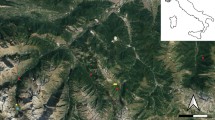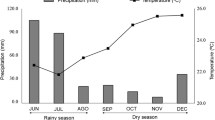Abstract
The cosmopolitan distribution of soil microarthropods and their various degrees of adaptation make them suitable tools for assessing soil ecosystem health. In this study, the microarthropod abundance of 25 home gardens in Kerala state located in South West coast of India was studied during summer and north east monsoon season of 2014. The soil microarthropods were categorized into six groups: collembola, coleoptera, hymenoptera, araeneae, acari and diplopoda. Their numbers varied from 0 to 28 per 1000 cm3 and were more abundant in the rainy season than in summer. The occurrence of these microarthropods was positively correlated to soil moisture and organic carbon and had negative correlation to soil temperature and soil pH. The presence of eu-edaphic and epi-edaphic microarthropod fauna was used to derive the soil quality index of each home garden and soil quality classes were defined. Out of the 25 home gardens, two were of good quality, 21 were of medium quality and two were of poor quality. The study supports the scope of applying the indicator value of soil microarthropods in future studies related to soil quality, management and conservation of tropical home garden ecosystems, which are facing threats of removal of canopy and unscientific land management practices.




Similar content being viewed by others
References
A’Bear AD, Boddy L, Jones TH (2013) Bottom-up determination of soil collembola diversity and population dynamics in response to interactive climatic factors. Oecologia 173(3):1083–1087
Andres P (1999) Ecological risks of the use of sewage sludge as fertilizer in soil restoration: effects on the soil microarthropod populations. Land Degrad Develop 10(1):67–77
Bandyopadhyaya I, Choudhuri DK, Ponge JF (2002) Effects of some physical factors and agricultural practices on Collembola in a multiple cropping programme in West Bengal (India). Eur J Soil Biol 38(1):111–117
Banerjee S, Sanyal AK, Bhaduri AK (2009) Studies on soil microarthropod population in three different garden plots of 24 Parganas, West Bengal-a preliminary report. Rec Zool Surv India 109(4):1–9
Begum F, Bajracharya RM, Sitaula BK, Sharma S, Ali S, Ali H (2014) Seasonal dynamics and land use effect on soil microarthropod communities in the mid-hills of Nepal. Int J Agron Agric Res 5(2):114–123
Bongers T (1999) The maturity index, the evolution of nematode life history traits, adaptive radiation and cp-scaling. Plant Soil 212:13–22
Cortet JR, Elmholt S, Coeurdassier M, Scheifler R, Krogh PH (2006) Interspecific relationships among soil invertebrates influence pollutant effects of phenanthrene. Environ Toxicol Chem 25(1):120–127
Coulson SJ, Fjellberg A, Melekhina EN, Taskaeva AA, Lebedeva NV, Belkina OA, Seniczak S, Seniczak A, Gwiazdowicz DJ (2015) Microarthropod communities of industrially disturbed or imported soils in the High Arctic; the abandoned coal mining town of Pyramiden, Svalbard. Biodivers Conserv 24(7):1671–1690
Culliney T (2013) Role of arthropods in maintaining soil fertility. Agriculture 3:629–659
Das T, Das AK (2005) Inventorying plant biodiversity in homegardens: a case study in Barak Valley. Curr Sci 89(1):155
Department of Agriculture and Cooperation (2011) Soil testing in India Ministry of Agriculture, Government of India
Department of Economics and Statistics (2013) Panchayath level statistics—2011 Ernakulam district, Government of Kerala
Fernandes ECM, Nair PKR (1986) An evaluation of the structure and function of tropical homegardens. Agric Syst 21:279–310
Galluzzi G, Eyzaguirre P, Negri V (2010) Home gardens: neglected hotspots of agro-biodiversity and cultural diversity. Biodivers Conserv 19:3635–3654
Parisi V, Menta C, Gardi, C, Jacomini C (2003) Evaluation of soil quality and biodiversity in Italy: the biological quality of soil index (QBS) approach. Agricultural impacts on soil erosion and soil biodiversity: developing indicators for policy analysis Rome. In: Proceedings from an OECD expert meeting, pp 1–12
Hagvar S (1990) Reactions to soil acidification in microarthropods: is competition a key factor. Biol Fertil Soils 9(2):178–181
Hartley W, Uffindell L, Plumb A, Rawlinson HA, Putwain P, Dickinson NM (2008) Assessing biological indicators for remediated anthropogenic urban soils. Sci Total Environ 405(1):358–369
Hodkinson ID, Coulson SJ, Webb NR, Block W (1996) Can high Arctic soil microarthropods survive elevated summer temperatures? Funct Ecol 10:314–321
Jensen M (1993a) Soil conditions, vegetation structure and biomass of a Javanese homegarden. Agrofor Syst 24:171–186
Jensen M (1993b) Productivity and nutrient cycling in a Javanese homegarden. Agrofor Syst 24:187–201
Jose D, Shanmugaratnam N (1993) Traditional homegardens of Kerala: a sustainable human ecosystem. Agrofor Syst 24(2):203–213
Kardol P, Reynolds WN, Norby RJ, Classen AT (2011) Climate change effects on soil microarthropod abundance and community structure. Appl Soil Ecol 47(1):37–44
Kautz T, Lopez-Fando C, Ellmer F (2006) Abundance and biodiversity of soil microarthropods as influenced by different types of organic manure in a long-term field experiment in Central Spain. Appl Soil Ecol 33(3):278–285
Kumar BM, Nair PR (2004) The enigma of tropical homegardens. Agrofor Syst 61(1–3):135–152
Kumar BM, George SJ, Chinnamani S (1994) Diversity, structure and standing stock of wood in the homegardens of Kerala in Peninsular India. Agrofor Syst 25:243–262
Macfadyen A (1961) Improved funnel-type extractors for soil arthropods. J Anim Ecol 30:171–184
Mackay WP, Silva S, Lightfoot DC, Pagani MI, Whitford WG (1986) Effect of increased soil moisture and reduced soil temperature on a desert soil arthropod community. Am Midl Nat 16:45–56
Mendez VE, Lok R, Somarriba E (2001) Interdisciplinary analysis of homegardens in Nicaragua: micro-zonation, plant use and socioeconomic importance. Agrofor Syst 51:85–96
Olfert O, Johnson GD, Brandt SA, Thomas AG (2002) Use of arthropod diversity and abundance to evaluate cropping systems. Agron J 94(2):210–216
Parisi V, Menta C, Gardi C, Jacomini C, Mozzanica E (2005) Microarthropod communities as a tool to assess soil quality and biodiversity: a new approach in Italy. Agric Ecosyst Environ 105:323–333
Radojevic M, Bashkin VN (2006) Practical environmental analysis. Royal Society of Chemistry, RSC, Cambridge
Rahman PM, Varma RV, Sileshi GW (2012) Abundance and diversity of soil invertebrates in annual crops, agroforestry and forest ecosystems in the Nilgiri biosphere reserve of Western Ghats, India. Agrofor Syst 85(1):165–177
Rusek J (1998) Biodiversity of Collembola and their functional role in the ecosystem. Biodivers Conserv 7(9):1207–1219
Rusek J, Marshall VG (2000) Impacts of airborne pollutants on soil fauna. Annu Rev Ecol Syst 31:395–423
Sankar S, Chandrashekara UM (2002) Development and testing of sustainable agroforestry models in different agroclimatic zone of Kerala with emphasis on socio-cultural, economic, technical and institutional factors affecting the sector. Research Report 234, Kerala Forest Research Institute, Peechi
Soil and Land Use Survey of India (2013) Inventory of soil & land resource of Ernakulam District, Kerala using remote sensing techniques. Report No. SRM:—12, Department of Agriculture & Co-operation, Ministry of Agriculture, Government of India
Soumya M, Nair PKR, Long AJ (2007) An assessment of ecological diversity in home gardens: a case study from Kerala State, India. J Sustain Agric 29(4):135–153
Swift M, Bignell D (2001) Standard methods for assessment of soil biodiversity and land use practice. International Centre for Research in Agroforestry, Bogor
Tizado EJ, Nunez‐Perez E (2014) Terrestrial arthropods in the initial restoration stages of anthracite coal mine spoil heaps in northwestern Spain: potential usefulness of higher taxa as restoration indicators. Land Degrad Develop. doi:10.1002/ldr.2280
Torquebiau E (1992) Are tropical agroforestry home gardens sustainable? International Centre for Research in Agroforestry (ICRAF). Agric Ecosyst Environ 41:189–207
Van Straleen N, Verhoef H (1997) The development of a bioindicator system for soil acidity based on arthropod pH preferences. J Appl Ecol 34:217–232
Verma D, Paliwal AK (2010) Effects of springtails community on plant growth. Biol Forum Int J 2(2):70–72
Verma D, Yadav RK, Kumar M (2014) Effect of ecological factors on population density of collembola in Agra. J Environ Appl Biores 2(1):25–28
Vreeken-Buijs MJ, Hassink J, Brussard L (1998) Relationships on soil microarthropods biomass with organic matter and pore size distribution in soil under different land use. Soil Biol Biochem 30:97–106
Yan S, Singh AN, Fud S, Liao C, Wanga S, Li Y, Cui Y, Huf L (2012) A soil fauna index for assessing soil quality. Soil Biol Biochem 47:158–165
Acknowledgments
The research is supported under the Junior Research Fellowship from Kerala State Council for Science, Technology and Environment (KSCSTE), Kerala, India. We also thank Cochin University of Science and Technology, Kerala, India for providing the research facilities.
Author information
Authors and Affiliations
Corresponding author
Rights and permissions
About this article
Cite this article
Lakshmi, G., Joseph, A. Soil microarthropods as indicators of soil quality of tropical home gardens in a village in Kerala, India. Agroforest Syst 91, 439–450 (2017). https://doi.org/10.1007/s10457-016-9941-z
Received:
Accepted:
Published:
Issue Date:
DOI: https://doi.org/10.1007/s10457-016-9941-z




